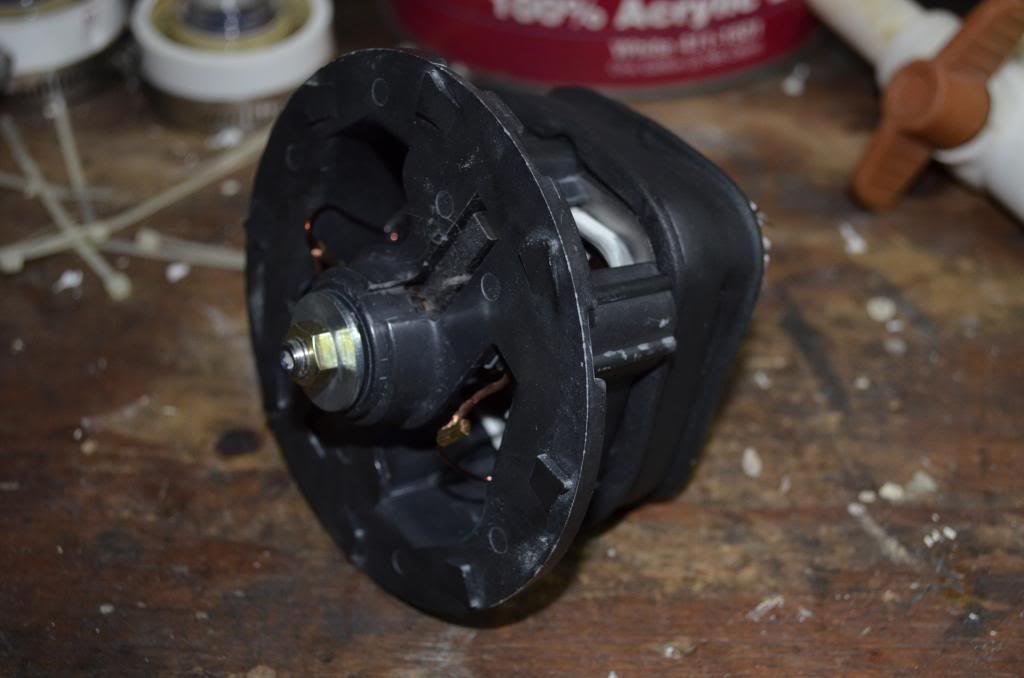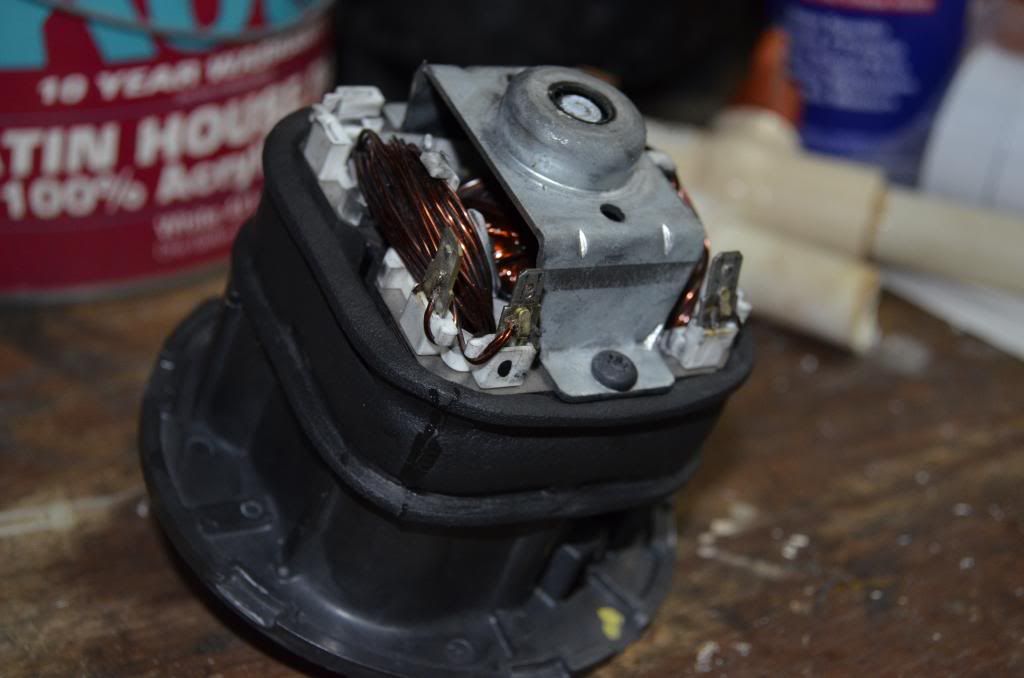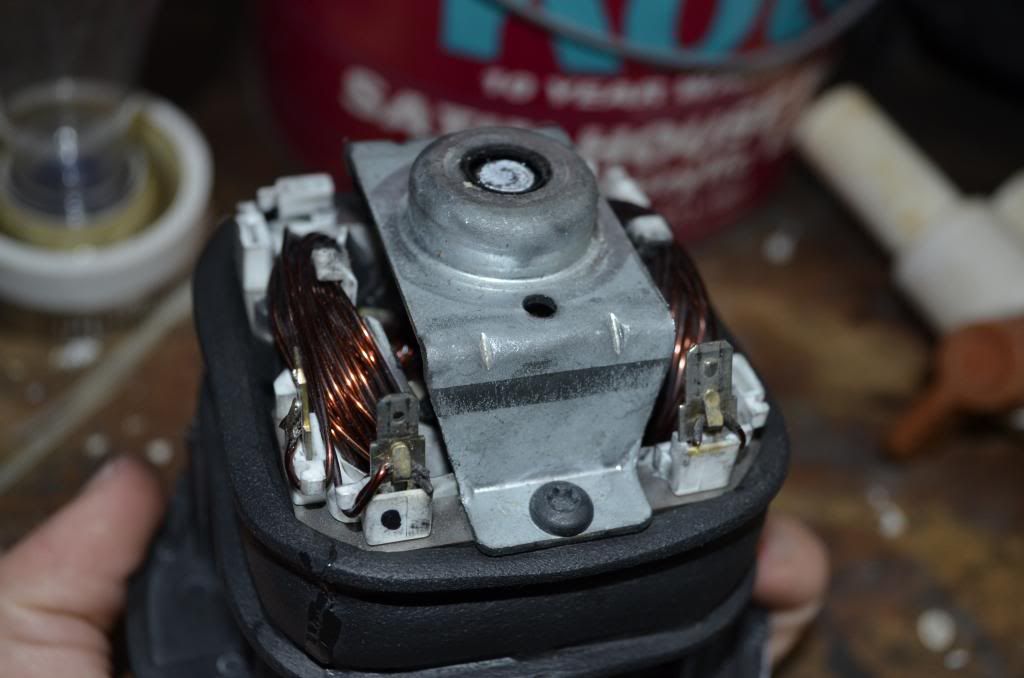Here is the motor:

And here is what the connections look like:


Any help is appreciated!
Thanks.






If you're asking me, I don't know. On the unit I took apart yesterday, only 2 wires went to the motor, and there were only 2 prongs on the motor. Same 120 VAC, 60 Hz. This is the only motor I have with 3 prongs, and its also the only one not made in China.POLAND_SPUD wrote:is the third one connected to any wire ?
If not it might be a prong for grounding

If a vacuum cleaner has a plastic body then there is usually no need for a ground line.Gun Freak wrote:If you are suggesting that it not be connected to anything, I think that is the correct way also. I also thought it might be used for grounding but I don't know if that is necessary? The vacuum I took apart yesterday only had a 2 prong plug, so there was no grounding wire anywhere in the circuit.
hectmarr wrote:You have to make many weapons, because this field is long and short life

jackssmirkingrevenge wrote:Hah! Again your affinity for domestic appliances associated with cleaning demonstrates your basic lack of testosterone!
If a vacuum cleaner has a plastic body then there is usually no need for a ground line.Gun Freak wrote:If you are suggesting that it not be connected to anything, I think that is the correct way also. I also thought it might be used for grounding but I don't know if that is necessary? The vacuum I took apart yesterday only had a 2 prong plug, so there was no grounding wire anywhere in the circuit.
By control panel do you mean circuit board? I think I actually do have the electronics still, but they won't do me any good.jrrdw wrote:Do you still have the control panel off the unit? Make and model #s ?




Ahhh, that makes sense.jimmy101 wrote:Sometimes a motor will have an extra terminal that energizes only part of the main windings giving a motor with two speeds. That might be what your extra terminal is. Since vacuum makers don't usually make their own motors that feature might just be part of that standard motor and wasn't used in the actual vacuum cleaner. Or, the extra lug might be for use on 220 VAC circuits (so the same vac can be sold in places with 220VAC service simply by swapping the hot wire to the motor).
I actually did look at the lugs and saw that the stand-alone lug had two scratch marks on it, so I assumed a wire needed to be connected to that one. I tested it by hooking up a 19V DC power supply to the motor with a switch. First I tried wiring the power to both of the lugs next to each other, and nothing happened, so I switched one wire. One wire went to the single lug, and I left the other wire on one of the paired lugs. It ran fine. However, I was unable to confirm your hypothesis of the motor having 2 speeds, because the lugs are differently sized, and my setup only allowed me to attach the wire to the smaller one of the two. Now I am curious to see if it will run at 2 different speeds... That would be really cool. I think I remember this vacuum having 2 speeds, but I took it apart quite a while ago so I'm not sure.jimmy101 wrote:If you have forgotten which terminals were actually used you might be able to tell from the wear pattern on the lugs. Those spade lugs generally get scratched along their edges if they are ever used.
I do have a volt-ohm meter, but I didn't think to use it. I'll try that out just for curiosity's sake.jimmy101 wrote: Do you have a volt-ohm meter? If the various lugs are common plus one or more windings then you should be able to figure that out based on conductivity and resistance. If one of the lugs is actually a ground then it should be conductive to say the metal frame of the motor and not conductive to any of the lugs that are connected to the windings.

http://www.ebay.com/itm/7-x-10-Precisio ... 33831369abGun Freak wrote:Surely you'd change your mind if you know I was using the motor to make another lathe?!?!
hectmarr wrote:You have to make many weapons, because this field is long and short life


I understand that, I was asking if there was a way to judge the rpm based off the frequency...jrrdw wrote:It depends on the size and amount of windings for the magnetic field that will be made or the speed you get out of it.


Low voltage meaning...? These motors won't run on voltage <9 voltsjrrdw wrote:It will work but running motors on low voltage can over heat them.